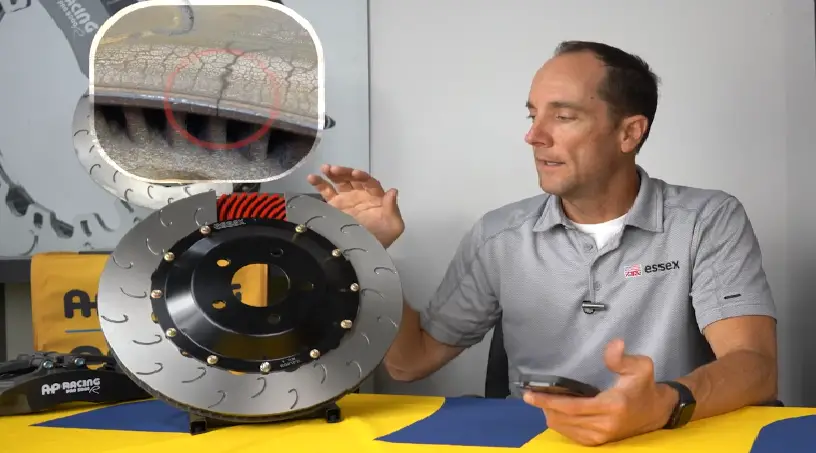Brake pads and discs are of utmost value in the brake system of a car because they work together to provide the friction necessary for effective brake power. The two components are prone to wear and tear with the passage of time, which may damage braking performance. This is where the question arises: Can you change brake discs without changing pads?
While the discs can be replaced without replacing pads, there are a few things to be kept in mind. In some cases, it would be less expensive or more secure to replace the pads and discs together in order to get maximum braking efficiency and avoid future issues.
2. What are Brake Discs and Brake Pads?
Before diving into whether you can swap the brake discs without replacing the pads, it’s crucial to understand how both components function within your vehicle’s braking system. Brake discs or rotors are large metal components that are attached to the wheel hub and rotate with the wheel.
The brake pads compress the discs when you apply the brakes, creating friction that slows down the car. Brake pads are wear materials that are designed to wear with time, but the brake discs also wear due to the constant friction. The two components together make your car stop effectively.
3. Function of Brake Discs and Pads in Braking System
In order to slow down or stop your car, the brake pads and brake discs create friction, and understanding the process can guide you through determining whether the two parts should be replaced.
The brake pads are pressed up against rotating brake discs by hydraulic fluid when the brake pedal is depressed. The friction created by pads and discs rubbing against each other produces heat and slows the wheels down. Brake pads and discs will both wear out due to this friction over time.
While pads tend to wear out faster than discs, both must work together in harmony in order to deliver continuous, effective braking ability.
4. Can You Replace Brake Discs Without Changing the Pads?
It is possible, in some cases, that you can replace the brake discs and not do the pads, but there are a few things you should remember before making this decision. If the brake pads are good and have sufficient thickness and even wear, then it is all right to just replace the discs.
But if the pads are worn out, worn, or unevenly worn out, replacement of only the discs might lead to ineffective braking. And the new discs can wear out prematurely if used with old, worn-out pads. It’s important to assess both components with caution before deciding whether to replace one or both.
5. When Should You Replace Brake Pads and Discs Together
Although it might be easy to simply replace the discs alone, there are times when replacing both pads and discs is advisable for maximum braking performance and safety. When the brake discs are severely grooved or warped, it could potentially create unbalanced pressure on the pads and thus ineffective braking. Replacing them together restores balance and guarantees even wear.
Also, in case the pads are at the end of their lifespan or cracked, replace both components at the same time to save time and prevent future issues. It also allows for better overall braking performance.
6. Warning Signs to Replace Both Brakes Pads and Discs
If your brake system indicates wear, it may be an indication that both the disc and brake pads must be replaced for better performance and safety. Warning signs include squeaking, squealing, or grinding noises during braking, which might be a sign of deteriorated pads or defective discs. Vibration or pulsation while braking may imply warping of brake discs and typically demands replacement of both.
Moreover, if your vehicle becomes slower to brake or braking is less responsive, it is time for a full overhaul of the brake system for optimal security and performance.
7. Pros and Cons of Replacement of Only Brake Discs
Replacing just the brake discs will save time and money but could lead to uneven wear and reduced braking efficiency in the long run. Its one advantage is that, if the pads are in good condition, you’re not wasting money on replacing them.
Its approach might, however, cause the new discs to wear out more or more unevenly, especially if the pads are old or damaged. If the pads are not replaced when they should be, it can also lower the overall performance of the braking system. That equates to having another replacement sooner than you had planned, wiping out any initial cost savings.
8. Cost Factors: Is It Less Priced to Only Replace the Discs?
Although it seems that replacing only the brake discs would be a cost-saving measure, there is a need to look at the long-term costs as well as potential risks. Substituting only the discs will save you money in the short term but, if the pads are badly worn, they will cause new discs to wear prematurely and, therefore, more repairs.
Also, if you leave both the parts to become due for replacement, you can anticipate poor braking performance, which can impact your car’s safety. In the majority of cases, the most economical alternative would be to replace both the pads and discs at the same time since it saves the hassle of future problems and gives consistent braking performance.
9. The Effect of Not Replacing Brake Pads While Replacing Discs
Not replacing brake pads while new discs are replaced can jeopardize the overall braking efficiency and cause excessive wear on new discs. The new discs won’t engage correctly. If the brake pads are worn out or broken, as this will reduce the car’s ability to slow down. This may lead to uneven disc wear, requiring premature replacement than designed.
Failure to replace the pads can also cause poor braking performance, longer stopping distance, and even safety hazards. It’s necessary to replace both pads and discs when they’re required in a bid to provide secure, reliable braking.
10. Brake Pad and Disc Check: DIY or Professional Repair?
You should regularly inspect your brake system, and although some owners may choose to do the check and replacement of the pads and discs themselves, professional repair is generally recommended for safety’s sake. DIY inspection can be done by checking the brake pads’ thickness with a gauge or visually checking the brake discs for wear, grooves, or warping.
But if you are not skilled in the maintenance of brake systems, it is safer to let a professional mechanic inspect the condition of both pads and discs. A skilled technician will ensure all functions are working and replace parts necessary to maintain the brakes in top shape.
FAQ’s
1. Can I change only the brake discs without changing the pads?
Yes, there is a possibility of changing the brake discs without changing the pads. However, one must check the condition of the pads to determine whether they need to be changed as well.
2. Must I always replace brake pads and discs together?
It is normally recommended to change the brake pads and discs at the same time when both of them are worn out considerably. Changing both will ensure even braking and prevent uneven wear on the new ones.
3. What happens if you don’t change the brake pads when you’re replacing the discs?
Not replacing brake pads at the time of disc replacement can lead to uneven braking, accelerated wear on the new discs, and safety risks.
4. How do I know if my brake pads need to be replaced with the discs?
If your brake pads are worn down to below the recommended thickness or there is grinding or squealing on the brakes, you need to replace them with the discs.
5. Is it less expensive to replace just the brake discs?
It is cheaper in the short run to replace just the brake discs, but it could cost more in the long run if the brake pads have to be replaced as well down the line.
6. Can I check my brake pads and discs myself?
While you might see your brake pads and discs yourself, it is best to have a qualified mechanic check them to ensure they are in good condition.
7. What are the risks of not replacing both the brake pads and discs?
Not replacing both the brake pads and discs will mean less braking power, potential harm to the new discs, and more expensive repairs down the line.
11. Conclusion
Ultimately, while it is technically possible to change brake discs without changing pads, it’s essential to consider your vehicle’s safety and performance needs when making this decision. If the brake pads are still in good condition and the wear is minimal, replacing just the discs may be acceptable.
But if the pads are damaged or worn out, then the ideal choice would be to replace the pads as well as discs so that the braking performance and safety are optimized. Always keep in mind the potential risks of skewed wear, lower braking capability, and future repair requirement while deciding whether to replace one or both parts.

I am Ryan Ford, a mountain biking enthusiast who loves to explore the outdoors. I also like to go on adventures with friends and anything else that involves being outside. I love my bike because it gets me out of the house and gives me an opportunity to enjoy nature.

